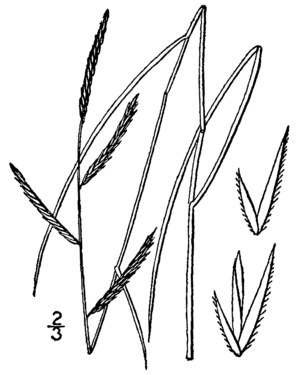Saltmeadow cordgrass facts for kids
Quick facts for kids Saltmeadow cordgrass |
|
|---|---|
 |
|
| 1913 illustration | |
| Scientific classification | |
| Kingdom: | |
| (unranked): | |
| (unranked): | |
| (unranked): | |
| Order: | |
| Family: | |
| Genus: |
Spartina
|
| Species: |
S. patens
|
| Binomial name | |
| Spartina patens |
|
The saltmeadow cordgrass, also called salt hay, is a type of grass. Its scientific name is Spartina patens. This plant naturally grows along the Atlantic coast of the Americas. You can find it from Newfoundland in Canada, all the way south to the eastern United States, the Caribbean, and northeast Mexico.
In 2014, scientists changed its official name to Sporobolus pumilus. However, many people still use the name Spartina patens. This grass can also be found in marshlands in other parts of the world. There, it is often an introduced species and can become a harmful invasive species.
Contents
What Saltmeadow Cordgrass Looks Like
This grass looks like hay and grows in the higher parts of salty coastal salt marshes. It is a thin, wiry plant that forms thick mats. These mats usually grow about 30 to 60 centimeters (1 to 2 feet) tall.
In spring and summer, the grass is green. It turns light brown in late fall and winter. Its stems are thin and hollow. The leaves roll inward, making them look round. Because the stems are weak, wind and water can bend the grass. This makes the field look like it has many tufts and messy patches, almost like a "cowlick" on someone's head.
Like its relative, the smooth cordgrass, saltmeadow cordgrass produces flowers and seeds on only one side of its stalk. The flowers are a deep purple color from June to October. They turn brown during the winter months.
Where Saltmeadow Cordgrass Lives
Saltmeadow cordgrass grows in high marsh areas. These areas are sometimes covered by very high tides. The plant has special cells that can keep salt from entering its roots. This helps it save fresh water. However, this grass does not like saltwater as much as some other marsh grasses. It can also grow on beaches and quickly regrow in areas washed over by storms.
Why Saltmeadow Cordgrass is Important
Healthy salt marshes need plants like salt hay grass and smooth cordgrass. These grasses create a rich home for many animals. This includes crustaceans like crabs, mollusks like snails, and different kinds of birds. The grasses also provide a lot of natural nutrients for the whole estuary. Many small animals live in the thick mats of salt hay grass. It is also an important food source for ducks and seaside sparrows.
Saltmeadow cordgrass marshes also help filter pollution. They act like a natural barrier against flooding and protect the shoreline from washing away. Long ago, during the colonial era, towns were often built near salt marshes. This was because saltmeadow cordgrass was very important for feeding farm animals. People harvested it for animal bedding and food, and also for garden mulch. Before hay was stored in barns, this grass was used to cover hay stacks in the fields.
Challenges and Invasive Nature
Many salt marshes in Rhode Island have been badly damaged. This happened because of filling, building, and road construction. These changes can stop the normal flow of tides. This often causes serious harm to the marsh's environment. Saltmeadow cordgrass needs a salty, wet place to grow. When tidal flow is blocked, the marsh can dry out. This allows invasive freshwater plants to grow instead.
Saltmeadow and smooth cordgrass often lose out to a plant called common reed. This happens in areas where human activity has disturbed or changed the marsh. Common reed is not as helpful or productive for a salt marsh as cordgrass.
While Spartina patens is a key plant in its native salt marsh homes, it is a harmful invasive species in other parts of the world. It is a big problem in the San Francisco Bay Area. There, it takes over from native plants like the soft salty bird's beak. It also changes the home of rare animals, such as the Ridgway's rail. This cordgrass arrived in the estuaries of Oregon with shipments of oysters. It has been seen taking over and crowding out native plants there. It has also appeared in marshes on the Iberian Peninsula, where it threatens the natural plant biodiversity.



